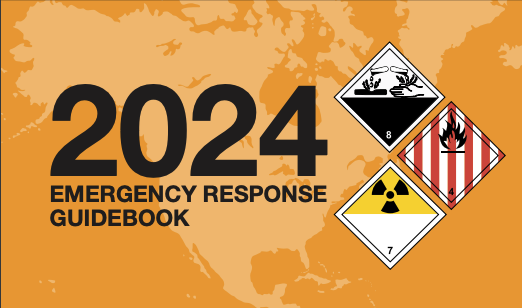
The 2024 edition of the Emergency Response Guidebook (ERG) has been released and it’s more comprehensive than ever before. ERG 2024 includes a number of important updates and is designed to offer valuable guidance to first responders and hazmat personnel in the event of hazardous material incidents.
ERG 2024 – What You Need to Know
PHMSA worked with a number of partners including the Canadian Transport Emergency Center (CANUTEC) as well as a team of chemists and first response professionals from around the world to develop ERG 2024. The guide is designed to provide all the information that first responders and hazmat employees need to respond effectively to emergencies involving hazardous materials.
As part of its efforts to achieve the goal of providing emergency response guides to all the public emergency service vehicles in the country, PHMSA is offering 1.8 million free copies of ERG 2024 to fire fighters, law enforcement officials, and other first responders across the country.
The key details about ERG 2024 include:
- It has been published in English, Spanish, and French to meet the needs of our nation’s diverse first responder community.
- It is available in the form of a print version as well as a mobile application. You can download the ERG mobile app for iOS here and the ERG mobile app for Android here. You can download the PDF version of ERG 2024 from this link.
- If you already have the 2020 version of the ERG mobile app, there is no need for you to download the latest version. The existing version of your app will automatically update itself.
- PHMSA has delivered print copies of ERG 2024 to state emergency management coordinators all over the country. Public safety agencies can get a free copy of the guide from their state coordinator’s office.
Changes in the 2024 Edition of the Emergency Response Guidebook
PHMSA states that a number of changes and updates have been made to make ERG 2024 as comprehensive as it can be – compared to the 2020 version. Here is an overview of the changes made in the 2024 edition.
Changes in the White Section
- The triangular Marine Pollutant marking and the yellow Division 5.2 placard have been removed from the Table of Markings, Labels, and Placards.
- New descriptive text has been added in the Road Trailer Identification Chart.
- A cryogenic railcar has been added to the Rail Car Identification Chart.
- A table has been added to help decide between Evacuation and Shelter-in-Place in the event of an emergency.
- A new section for Liquid Spill Control methods has been added.
- Considerations for Lithium Battery and Electric Vehicle Fires and identification of damaged, defective, or recalled (DDR) lithium batteries have been added.
- A new section called Chemical and Biological Warfare Agents has been created under the Criminal or Terrorist Use of Chemical, Biological, and Radiological Agents section. All Chemical and Biological Warfare Agents considerations in different sections of the guide have been consolidated under this section.
- The glossary has been expanded to include 14 new terms.
Changes in the Yellow and Blue Sections
- 11 new UN numbers have been added and 8 existing UN numbers have been removed.
- 19 materials have been moved to a different guide.
- Polymerization hazard (P) has been added to UN3302 – 2-Dimethylaminoethyl acrylate, stabilized.
Changes in the Orange Section
- All the general first aid recommendations have been moved to a new section called General First Aid – with the exception of material-specific recommendations, which have been retained in Orange Guide pages.
- The safety and emergency response information in 15 guides (115, 118, 128, 130, 131, 136, 138, 140, 147, 151, 153, 156, 159, 166, and 171) has been revised and updated.
Changes in the Green Section
- Distances in Table 1 and Table 3 have been revised.
A more detailed summary of the changes and updates made to the 2024 edition of the Emergency Response Guidebook can be found here.
Who Needs to Have the Emergency Response Guidebook?
Though the Emergency Response Guidebook is primarily meant for first responders, if you are involved in the pre-transportation or transportation of hazardous materials in any way, it is essential for you to have a copy of the guidebook. The information in the guidebook can help you respond effectively to emergencies involving hazardous materials and mitigate the consequences.
Improve Your Emergency Response Preparedness with Hazmat University’s Online Hazmat Training Courses
Emergency response training can help you mitigate the risks of hazmat incidents to a great extent for each major mode of transportation. At Hazmat University, we offer industry-leading online courses designed to meet the needs of hazmat personnel like you. From mode-specific training courses to multimodal courses, initial training to recurrent training courses, we have covered all your regulatory requirement needs.
Our online courses cover a wide range of subjects – from identification and classification of different classes of hazardous materials to safety and emergency response preparedness. We make sure you are equipped with the knowledge, skills, and training you need to perform your duties safely and efficiently.
Join thousands of satisfied learners and enroll in our courses today. Call us at 844-307-8345 or get in touch with us online to know more about our hazmat training courses.
Be Confident. Be Competent. Be Compliant.